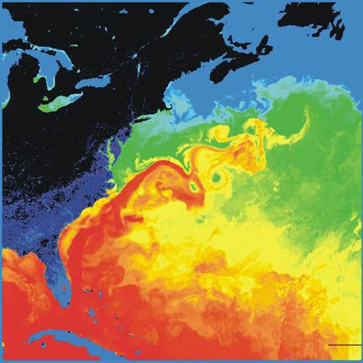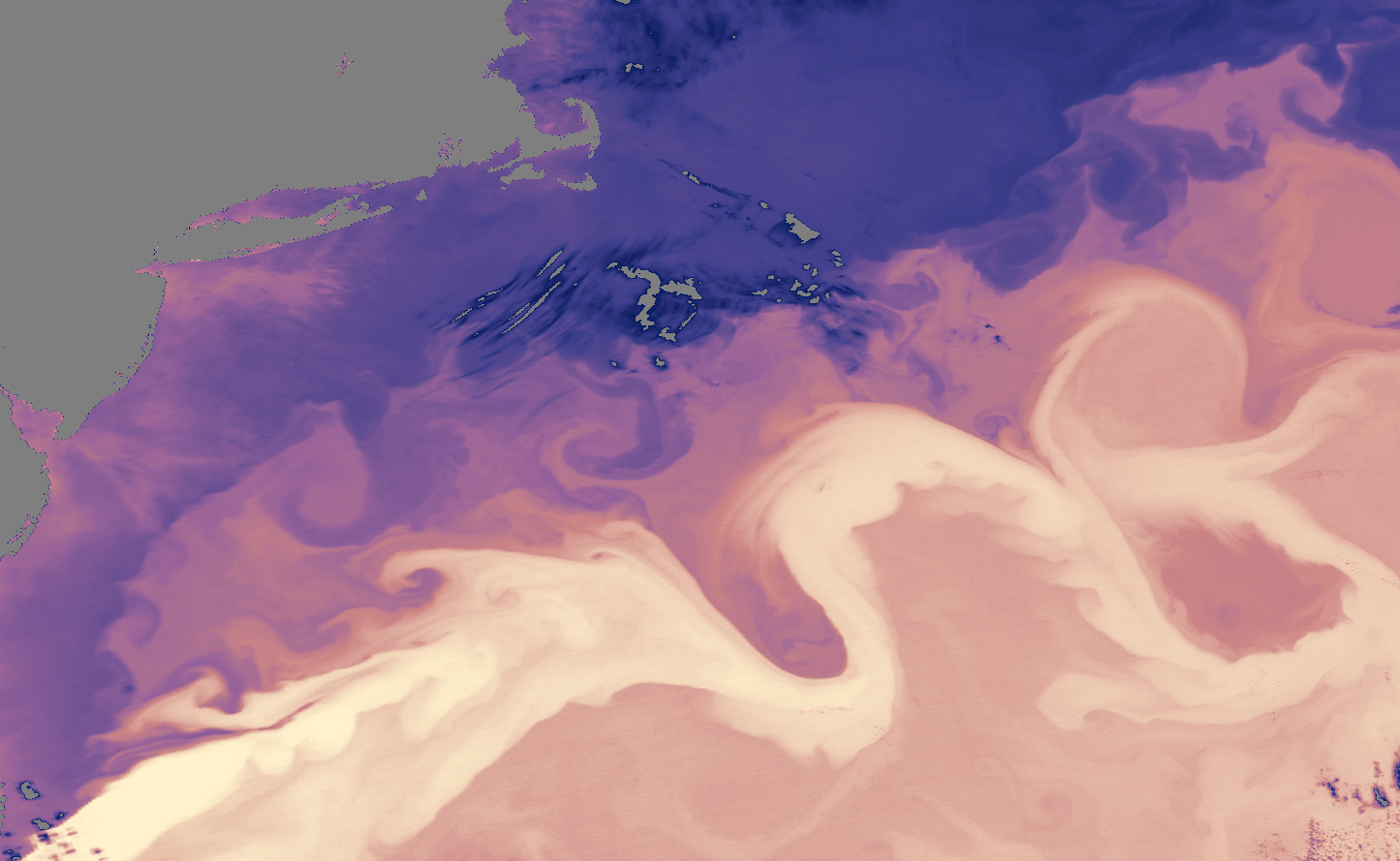
 Cold-core rings are a type of oceanic
Cold-core rings are a type of oceanic eddy
Eddy may refer to:
* Eddy (surname), surname used by descendants of a number of English, Irish and Scottish families
* Eddy (given name), male given name
* Eddy (fluid dynamics), the swirling of a fluid and the reverse current created when the fl ...
, which are characterized as unstable, time-dependent swirling, independent "cells" that separate from their respective ocean current and move into water bodies with different physical, chemical, and biological characteristics, often bringing the characteristics of the waters of their origin into the water bodies into which they travel. Their size can range from to over in diameter with depths over . Cold-core rings are the product of warm water currents wrapping around a colder water mass as it deviates away from its respective current. The direction an eddy swirls can be categorized as either cyclonic or anticyclonic, which is, in the Northern Hemisphere, counterclockwise and clockwise respectively, and in the Southern Hemisphere, clockwise and counterclockwise respectively as a result of the Coriolis effect
In physics, the Coriolis force is a pseudo force that acts on objects in motion within a frame of reference that rotates with respect to an inertial frame. In a reference frame with clockwise rotation, the force acts to the left of the moti ...
. Although eddies have large amounts of kinetic energy
In physics, the kinetic energy of an object is the form of energy that it possesses due to its motion.
In classical mechanics, the kinetic energy of a non-rotating object of mass ''m'' traveling at a speed ''v'' is \fracmv^2.Resnick, Rober ...
, their rotation is relatively quick to decrease in relation to the amount of viscous friction in water. They typically last for a few weeks to a year. The nature of eddies are such that the center of the eddy, the outer swirling ring, and the surrounding waters are well-stratified and maintain all of their distinctive physical, chemical, and biological properties throughout the eddy's lifetime, before losing their distinctive characteristics at the end of the life of the cold-core ring.
Formation
The governing forces of an eddy are very dependent on its size. Small eddies are largely governed by viscosity and direction of the flow of a water body. However, larger eddies are formed from a balance between the horizontal pressure gradient force, arising from differences in densities of the meeting water masses, and the Coriolis force. Due to the turbulent nature of the Earth's oceans, eddies can be found almost everywhere.Mesoscale eddies
In fluid dynamics, an eddy is the swirling of a fluid and the reverse current created when the fluid is in a turbulent flow regime. The moving fluid creates a space devoid of downstream-flowing fluid on the downstream side of the object. Fluid ...
are usually seen in areas of intense, meandering currents such as the Gulf Stream and the Antarctic Circumpolar Current that feeds into the South Pacific and Indian oceans, but in general can be caused by a combination of factors such as cooling of sea surface temperature
Sea surface temperature (or ocean surface temperature) is the ocean temperature, temperature of ocean water close to the surface. The exact meaning of ''surface'' varies in the literature and in practice. It is usually between and below the sea ...
, convection, direct generation from wind, or flow past an irregular or jagged coastline. Cyclonic cold-core eddies are frequently formed at the polar front by the Gulf Stream
The Gulf Stream is a warm and swift Atlantic ocean current that originates in the Gulf of Mexico and flows through the Straits of Florida and up the eastern coastline of the United States, then veers east near 36°N latitude (North Carolin ...
and Labrador Current
The Labrador Current is a cold current in the North Atlantic Ocean which flows from the Arctic Ocean south along the coast of Labrador and passes around Newfoundland, continuing south along the east coast of Canada near Nova Scotia. Near Nova Sco ...
. The cold, nutrient-rich waters from the Labrador Sea
The Labrador Sea (; ) is an arm of the North Atlantic Ocean between the Labrador Peninsula and Greenland. The sea is flanked by continental shelf, continental shelves to the southwest, northwest, and northeast. It connects to the north with Baffi ...
flow south and get caught in the eastward meandering of the Gulf Stream, traveling eastward across the Atlantic Ocean. Generally, cold-core rings are formed when meanders expanding southeast are pinched from the Gulf Stream.
Permanent and semi-permanent cold core rings
Semi-permanent and permanent eddies are also relatively abundant throughout the world. These permanent and semi-permanent rings often form systematically in the same manner and often with the same drift and properties. Some permanent eddies are regular enough to be given names within the ocean current system, such as the cold-core Agulhas Ring off the tip ofSouth Africa
South Africa, officially the Republic of South Africa (RSA), is the Southern Africa, southernmost country in Africa. Its Provinces of South Africa, nine provinces are bounded to the south by of coastline that stretches along the Atlantic O ...
. Western boundary currents like the Agulhas Agulhas (''needles'' in the Portuguese language — or ) may refer to:
* Cape Agulhas, the southernmost point of Africa
* L'Agulhas, a town near the Cape
* Cape Agulhas Lighthouse, located at the Cape
* Cape Agulhas Local Municipality, the municipa ...
, Brazil
Brazil, officially the Federative Republic of Brazil, is the largest country in South America. It is the world's List of countries and dependencies by area, fifth-largest country by area and the List of countries and dependencies by population ...
, and East Australian Currents are known for shedding eddies downward off from their ending points. A semi-permanent cold-core eddy is periodically formed by the Loop Current
Mesh analysis (or the mesh current method) is a circuit analysis method for planar circuits; planar circuits are circuits that can be drawn on a plane surface with no wires crossing each other. A more general technique, called loop analysis ...
in the eastern Gulf of Mexico
The Gulf of Mexico () is an oceanic basin and a marginal sea of the Atlantic Ocean, mostly surrounded by the North American continent. It is bounded on the northeast, north, and northwest by the Gulf Coast of the United States; on the southw ...
, where warm water from the South Equatorial Current
The South Equatorial Current are ocean currents in the Pacific, Atlantic, and Indian Ocean that flow east-to-west between the equator and about 20 degrees south. In the Pacific and Atlantic Oceans, it extends across the equator to about 5 degre ...
travels upwards through the southern Caribbean Sea
The Caribbean Sea is a sea of the Atlantic Ocean, North Atlantic Ocean in the tropics of the Western Hemisphere, located south of the Gulf of Mexico and southwest of the Sargasso Sea. It is bounded by the Greater Antilles to the north from Cuba ...
and flows into the Loop Current off the coast of Cancun.
Characteristics and structure
Despite being surrounded by the highly saline and generally nutrient-devoid waters in the middles of oceanic gyres, cold-core rings, especially those found in theSargasso Sea
The Sargasso Sea () is a region of the Atlantic Ocean bounded by four currents forming an ocean gyre. Unlike all other regions called seas, it is the only one without land boundaries. It is distinguished from other parts of the Atlantic Oc ...
from the Gulf Stream, have the ability to transport the nutrients and biota of the colder regions from which they originated into the warmer regions into which they travel. In Gulf Rings, the transport of nutrients facilitated by the cold-core rings may be instrumental in sustaining the reduced productivity of the Sargasso Sea. As such, the cold-core rings formed off the Gulf Stream are likely to influence the widespread distribution of zooplankton
Zooplankton are the heterotrophic component of the planktonic community (the " zoo-" prefix comes from ), having to consume other organisms to thrive. Plankton are aquatic organisms that are unable to swim effectively against currents. Consequent ...
. The sizes of cold-core rings can vary, typically from , and they can at a speed of .
All eddies are capable of transporting energy, momentum, heat, physical and chemical water properties, and even small organisms across very large distances, even when surrounded by waters that would not be conducive to the same. Since eddies mix waters with different properties, they act as exchanges of nutrients from the continental shelf to the deeper ocean with differing properties as they travel. This makes them ideal locations for primary productivity, especially in areas of low nutrients, such as the centers of open ocean gyres, such as the Sargasso Sea. The importance of these swirling masses lies in the incredible amount of kinetic energy they are able to transport both horizontally and vertically, their participation in air-sea interactions, and the irreversible mixing of water masses. These processes all contribute to the transfer of nutrients, oxygen, and trace chemicals, ocean stratification
Ocean stratification is the natural separation of an ocean's water into horizontal layers by Density of water, density. This is generally stable stratification, because warm water floats on top of cold water, and heating is mostly from the sun, whi ...
and density fields, and patterns of warmth that drive atmospheric and oceanic circulation.
Transportation and habitation of organisms
 In a study conducted in 1993, it was shown that cold-core rings had the ability to transport species such as
In a study conducted in 1993, it was shown that cold-core rings had the ability to transport species such as medusae
Jellyfish, also known as sea jellies or simply jellies, are the medusa-phase of certain gelatinous members of the subphylum Medusozoa, which is a major part of the phylum Cnidaria. Jellyfish are mainly free-swimming marine animals, althoug ...
and siphonophores
Siphonophorae (from Ancient Greek σίφων (siphōn), meaning "tube" and -φόρος (-phóros), meaning "bearing") is an Order (biology), order within Hydrozoa, a class of marine organisms within the phylum Cnidaria. According to the World Re ...
, and that even while surrounded completely by a warmer body of water, the medusae that were abundant outside of the cold-core ring were not abundant within, and vice versa, showing that the conditions within and without the cold-core ring are conducive to certain species of medusae that otherwise would not be able to thrive in the original waters.
See also
* Warm core ring *Gulf Stream
The Gulf Stream is a warm and swift Atlantic ocean current that originates in the Gulf of Mexico and flows through the Straits of Florida and up the eastern coastline of the United States, then veers east near 36°N latitude (North Carolin ...
* Vortex shedding
In fluid dynamics, vortex shedding is an oscillating flow that takes place when a fluid such as air or water flows past a bluff (as opposed to streamlined) body at certain velocities, depending on the size and shape of the body. In this flow, v ...
References
{{reflist Physical oceanography